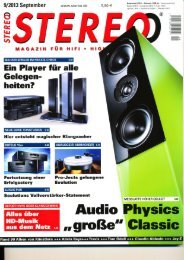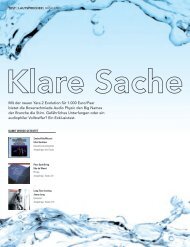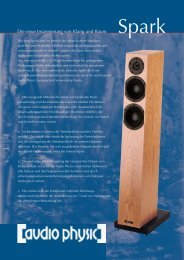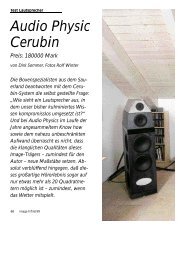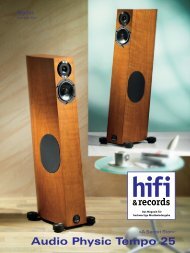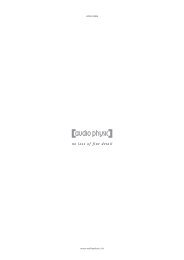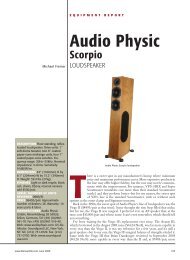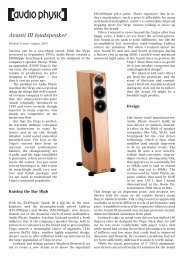Specialities from the Sauerland region - Audio Physic
Specialities from the Sauerland region - Audio Physic
Specialities from the Sauerland region - Audio Physic
You also want an ePaper? Increase the reach of your titles
YUMPU automatically turns print PDFs into web optimized ePapers that Google loves.
40 Test Lautsprecher <strong>Audio</strong> <strong>Physic</strong> Classic 20<br />
Sauerländer<br />
Spezialitäten<br />
Muss ein guter Lautsprecher eigentlich immer<br />
hässlich wie die Nacht, zumindest aber nach<br />
innenarchitektonischen Maßstäben schwer in ein<br />
Wohnambiente integrierbar sein?<br />
Wenn man sich die richtig angesagten<br />
Lautsprecher so ansieht,<br />
dann kann man den Eindruck gewinnen,<br />
dass eine gelungene Gestaltung ein effektiver<br />
Klangverhinderer ist. Vielleicht ist es<br />
auch so, dass der Klangfreak einigermaßen<br />
hübschen Kreationen des Genres intuitiv<br />
misstraut: Wenn’s gut aussieht, dann ist es<br />
bestimmt kein „Form-Follows-Function“-<br />
Design, und dann kann’s ja eigentlich<br />
nichts taugen. Oder?<br />
Den Gegenbeweis versucht einer der alteingesessenen<br />
deutschen Lautsprecherhersteller<br />
in Gestalt von <strong>Audio</strong> <strong>Physic</strong>. Dass<br />
die gute Lautsprecher bauen können, steht<br />
völlig außer Frage, nicht umsonst ist die<br />
„Avantera“ seit Jahren bei uns unverzichtbares<br />
Hilfsmittel im täglichen Testbetrieb.<br />
Nun ist der Dreiwegerich mit dem geschwungenen<br />
Rücken zwar ein absolut gelungen<br />
gestyltes Produkt, aber immer noch<br />
ein reichlich dominantes Möbelstück, das<br />
längst nicht in jedes Wohnzimmer darf.<br />
Und außerdem ist das Vergnügen auch<br />
nicht ganz billig.<br />
Seit geraumer Zeit gibt’s von <strong>Audio</strong> <strong>Physic</strong><br />
eine Lautsprecherserie mit der unspektakulären<br />
Typenbezeichnung „Classic Line“.<br />
Dazu gehören insgesamt sieben Modelle:<br />
drei Standboxen, eine Kompakte, ein Subwoofer<br />
und diverses Heimkino-Gedöns.<br />
Wir nehmen uns hier der mittleren Standbox<br />
namens „Classic 20“ an. Die gibt’s für<br />
2.400 Euro pro Paar zu erstehen und bietet<br />
weit mehr, als der erste Anschein hergibt.<br />
Oder besser: Sie bietet tatsächlich das, was<br />
der erste Blick vermuten lässt: eine Gehäuseoberfläche<br />
aus Glas. Nicht schnödes<br />
Acryl, sondern richtiges, echtes Glas.<br />
Solches, in das man nicht beim Putzen<br />
Kratzer hineinpoliert. Dem gemeinen Boxenkenner<br />
sträuben sich bei dem Material<br />
spontan die Nackenhaare. Das „klingelt“<br />
doch wie verrückt? Deshalb darf man seine<br />
Geräte doch auch nicht in Racks mit<br />
Glasboden stellen? Keine Panik: Natürlich<br />
besteht das Gehäuse nicht aus massivem<br />
Glas. Vielmehr sind die rückseitig farbig<br />
bedruckten Platten mit einem dämpfenden<br />
Klebeband mit etwas Abstand auf<br />
ein MDF-Gehäuse geklebt. Und in dieser<br />
Konstellation ist das Glas nicht nur nicht<br />
schädlich, sondern leistet sogar aktiv seinen<br />
Beitrag zur Ruhigstellung der Wände<br />
und reduziert den Schalldurchtritt deutlich.<br />
<strong>Audio</strong> <strong>Physic</strong> bietet diese Oberfläche<br />
in zehn verschiedenen Farben an, und wer<br />
Nr_6-2013
Lautsprecher Test 41<br />
Der Hochtöner ist ein bewährtes Modell<br />
mit 30-Millimeter-Gewebemembran<br />
nun so gar nicht damit klarkommt, der<br />
darf sich auch eines von vier Holzfurnieren<br />
aussuchen und noch 200 Euro sparen.<br />
Zum Lieferumfang unserer weißen Testexemplare<br />
gehören außerdem gleich zwei<br />
verschiedene Schallwandabeckungen: Die<br />
Glasversion hat zwei Öffnungen für Mittelund<br />
Hochtöner, die Stoffvariante deckt die<br />
Treiber und wirkt noch dezenter.<br />
Die Classic 20 ist eine Dreiwegebox. Mittel-<br />
und Hochtöner sitzen ordnungsgemäß<br />
auf der Front, Der Bass hingegen versteckt<br />
sich. Konstrukteur Manfred Diestertich<br />
wollte ihn nämlich keinesfalls einfach auf<br />
der Seitenwand montieren, das hätte ungünstige<br />
Krafteinwirkungen seitlich auf<br />
das Gehäuse zur Folge – deshalb gibt‘s bei<br />
den größeren Modellen immer mindestens<br />
zwei gegenüberliegende Bässe, das<br />
kompensiert den Effekt. Hier ging Diestertich<br />
einen anderen Weg: Das Bassgehäuse<br />
läuft unten V-förmig zu, der Bass sitzt auf<br />
einer der Schrägen. Das macht die Angelegenheit<br />
erheblich stabiler. Der Tieftöner<br />
arbeitet auf ein Reflexgehäuse, die entsprechende<br />
Öffnung strahlt nach unten ab. Von<br />
all dem sieht man nichts; die Anordnung<br />
steckt im unteren Drittel der Box, die entsprechenden<br />
Öffnungen sind mit Stoffabdeckungen<br />
verschlossen.<br />
<strong>Audio</strong> <strong>Physic</strong> setzt konsequent auf Treiber<br />
vom Zulieferer Wavecor; mal kommen<br />
Serienmodelle zum Einsatz, mal sind’s<br />
Sonderanfertigungen für die Sauerländer.<br />
Bei der Classic 20 übernimmt eine mit 30<br />
Millimetern Durchmesser ziemlich große<br />
Gewebekalotte den Hochtonpart. Eine<br />
breite Sicke erlaubt große Hübe und damit<br />
ordentlich Dynamik, ein auf die Front<br />
aufgeklebter sternförmiger Schaumstoffdämpfer<br />
Reflexionen soll vermeiden. Der<br />
Tiefmitteltöner durchmisst 13 Zentimeter,<br />
verfügt über ein modernes Korbdesign mit<br />
schlanken Streben und ist von hinten gut<br />
belüftet; das minimiert mechanische Verluste<br />
effektiv. Mittig auf dem Magneten<br />
sitzt ein Phase-Plug, der das Abstrahlverhalten<br />
verbessert. Der im Verborgenen<br />
werkelnde 18-Zentimeter-Bass ist ein für<br />
seine Tieftonpotenz bekanntes Modell, das<br />
andernorts auch schon mal als Aktivsubwoofer<br />
zum Einsatz kommen darf.<br />
Eine eingehende Betrachtung ist auf alle<br />
Fälle die Boxenrückseite wert: Hier gibt’s<br />
nämlich keine schnöden Buchsen vom Billiganbieter,<br />
sondern Nextgen-Polklemmen<br />
von WBT, erfahrungsgemäß das Beste, was<br />
der Markt für Terminals so zu bieten hat.<br />
Fein säuberlich in einer Aluminiumplatte<br />
montiert – so macht man das.<br />
Nimmt man all diese Features, das exklusive<br />
Gehäuse und den Umstand, dass diese<br />
Lautsprecher tatsächlich in Deutschland<br />
gefertigt werden, dann rückt das Preis-<br />
Leistungs-Verhältnis in ein ganz neues<br />
Licht: Die Classic 20 ist nämlich ein absolutes<br />
Sonderangebot. Jetzt muss sie nur<br />
noch klanglich das halten, was sie technisch<br />
verspricht.<br />
Gerade habe ich die Fünfzehnzoll-Pappen<br />
an die Seite gewuchtet, die Röhrenverstärker<br />
abgeklemmt, nun sollen diese niedlichen<br />
kleinen Standböxchen den Job übernehmen.<br />
Junge, bist du doof? Entwöhne<br />
dich doch erst mal eine Nacht, sonst erlebst<br />
du doch gleich den Absturz deines Lebens<br />
und wirst kein gutes Haar an diesen „Real-<br />
Mitspieler<br />
Plattenspieler:<br />
· Transrotor Zet 3 / 5012 / Merlo<br />
Reference<br />
Phonovorstufen:<br />
· Pure Sound P10, Übertrager T10<br />
Vollverstärker:<br />
· Accuphase E-260<br />
· Pioneer A-70<br />
Zubehör:<br />
· Netzsyn<strong>the</strong>sizer PS <strong>Audio</strong> P10<br />
· NF-Kabel von van den Hul und<br />
Transparent<br />
· Phonokabel van den Hul<br />
· Lautsprecherkabel von Transparent<br />
· Plattenwaschmaschine von<br />
Clearaudio<br />
Gegenspieler<br />
Lautsprecher:<br />
· <strong>Audio</strong> <strong>Physic</strong> Avantera<br />
· Klang + Ton Nada<br />
<strong>Audio</strong> <strong>Physic</strong> verwendet<br />
trickreiche Hightech-Materialien<br />
zur Gehäusedämmung,<br />
Polyesterwatte war gestern<br />
Alternativ kann eine Stoffbespannung<br />
anstelle der Glasfront aufgesteckt werden<br />
Nr_6-2013
42 Test Lautsprecher <strong>Audio</strong> <strong>Physic</strong> Classic 20<br />
Billy Talent – Billy Talent<br />
Gespieltes<br />
Billy Talent<br />
Billy Talent<br />
Sound City OST<br />
oreolB<br />
Maurice Ravel<br />
Neil Young<br />
Psychedelic Pill<br />
Gemessenes<br />
Messtechnik-Kommentar<br />
Der Frequenzgang der Classic 20 ist weitgehend<br />
ausgewogen. Es gibt einen kleinen Buckel<br />
im Oberbassbereich und einen leichten<br />
Anstieg zu hohen Frequenzen hin. Jenseits<br />
von 10 kHz wird die Kalotte langsam leiser,<br />
aber das bewegt sich alles im Rahmen. Das<br />
Rundstrahlverhalten ist gut, die Box liefert<br />
im Mittel 87 Dezibel Schalldruck. Der Impedanzschrieb<br />
weist im Mittel vier Ohm aus. Das<br />
Klirrverhalten ist gutmütig, die Verzerrungen<br />
beschränken sich im Wesentlichen auf unproblematische<br />
k2-Anteile. Bei 95 Dezibel Schalldruck<br />
zeigt der Hochtöner eine kleine Klirrspitze<br />
bei gut 4 kHz, die aber klanglich nicht<br />
auszumachen ist.<br />
Life-Boxen“ lassen. Habe ich gedacht. Interessanterweise<br />
völlig zu Unrecht. Tatsächlich<br />
nämlich sind die Classic 20 völlig ohne<br />
Probleme in der Lage, unseren nicht eben<br />
kleinen Hörraum überzeugend mit Musik<br />
zu füllen. Da fiel mir zufällig das erste<br />
Billy-Talent-Album in die Hände und die<br />
vier Jungs aus Kanada waren genau richtig,<br />
um mal ganz vorsichtig zu gucken, was<br />
denn in Sachen Grobdynamik so drin ist.<br />
DIe Glasoberfläche gibt dem<br />
Gehäuse ein wertiges Aussehen<br />
und gibt auch akustisch Sinn<br />
Das Lautsprecherterminal ist exzellent,<br />
will aber praktisch ausschließlich mit<br />
Kabelschuhen bedient werden<br />
„Standing In The Rain“ zerstreute sämtliche<br />
Bedenken in dieser Hinsicht nachhaltig.<br />
Der Achtzehner im Fuß der Box pumpt<br />
Bassdrum- und Bassattacken so rotzfrech<br />
in den Raum, dass es eine wahre Freude ist.<br />
Schade, dass das Album einen so überrissenen<br />
Präsenzbereich hat, sonst könnte die<br />
Vollgasscheibe sogar fast gut klingen. Auch<br />
Stevie Nick„Can‘t Fix This“, der entspre-<br />
<strong>Audio</strong> <strong>Physic</strong> Classic 20<br />
· Preis ab 2.200 Euro<br />
· Vertrieb <strong>Audio</strong> <strong>Physic</strong>, Brilon<br />
· Telefon 02961 96170<br />
· Internet www.audiophysic.de<br />
· Garantie 2 Jahre<br />
· B x H x T ca. 170 x 1055 x 290 mm<br />
· Ausführungen 10 Glasoberflächen,<br />
4 Furniere<br />
Unterm Strich …<br />
» Die Classic 20 ist eine potente, stimmige Box,<br />
die problemlos in ein modernes<br />
Wohnambiente zu integrieren ist<br />
und mit einem überaus fairen Preisschild<br />
ausgestattet ist.<br />
Nr_6-2013
Zwei verschiedene „Netzfüße“<br />
erlauben unterschiedlich starke<br />
Entkopplung vom Untergrund<br />
Der Tiefmitteltöner<br />
ist eine sehr moderne<br />
Entwicklung mit sehr<br />
„luftigem“ Design<br />
chende Titel vom „Sound-City“-Soundtrack, löst sich aber<br />
klasse von den Boxen, hat Power und Durchsetzungsvermögen.<br />
Okay, im Oberbassbereich tut die Box manchmal ein<br />
wenig reichlich, aber bitte sehr: Ein bisschen Bassvolumen<br />
darf man ruhig auf diesem Wege „ergaunern“. Die Classic 20<br />
ist eine gefällige Box, keine sperrige Diva, mit deren Eigenheiten<br />
man erst zu leben lernen muss. Hinstellen, leicht auf<br />
den Hörer einwinkeln, und los geht‘s. Ein gutes Rundstrahlverhalten<br />
auch in der Vertikalen sorgt dafür, dass man nicht<br />
am Hörplatz angenagelt sein muss, sondern auch mal aufstehen<br />
und im Raum umhergehen darf, ohne dass die Tonalität<br />
komplett zusammenbricht. Die Box weiß auch mit weniger<br />
rustikalem Material zu gefallen: Der großartige rückwärts<br />
geschnittene Bolero von Tacet öffnet einen riesigen Raum,<br />
abermals verschwinden die Boxen selbst physisch aus dem<br />
Geschehen. Der Mittel- und Hochton bilden eine völlig stimmige<br />
Einheit, servieren einen sanften, aber detaillierten Streicherklang<br />
mit Schmelz und Inbrunst. Bläser haben Energie,<br />
nerven aber nicht – genau so kenne ich das von einer guten<br />
Gewebekalotte.<br />
Das Klangbild der Classic 20 ist absolut makellos. Die Box<br />
suggeriert viel mehr Physis, als tatsächlich vorhanden ist, und<br />
spielt rundum geschlossen. Hier merkt man die langjährige<br />
Erfahrung des Herstellers bei jedem Ton. Kompliment zu einer<br />
tollen Box, die auch noch verdammt gut aussieht.<br />
Holger Barske<br />
Die Glasoberfläche ist in diesen zehn Farbtönen lieferbar
40 Loudspeaker Test <strong>Audio</strong> <strong>Physic</strong> Classic 20<br />
<strong>Specialities</strong> <strong>from</strong> <strong>the</strong><br />
<strong>Sauerland</strong> <strong>region</strong><br />
Does a good loudspeaker really always have<br />
to be as ugly as <strong>the</strong>y come or at least difficult<br />
to integrate into a living atmosphere in line<br />
with <strong>the</strong> current standards of interior design?<br />
At first glance, <strong>the</strong> latest loudspeaker trends<br />
sometimes tend to leave <strong>the</strong> impression that<br />
such successful design is actually concealing<br />
a real sound-killer. It may also be <strong>the</strong> case that<br />
true sound freaks intuitively mistrust relatively<br />
attractive loudspeakers. After all, if a loudspeaker<br />
looks good, it certainly can’t feature a<br />
‘form-follows-function’ design and <strong>the</strong>refore<br />
can't actually be much of a success, right?<br />
A long-established German loudspeaker<br />
manufacturer, <strong>the</strong> company <strong>Audio</strong> <strong>Physic</strong> <strong>from</strong><br />
<strong>the</strong> <strong>Sauerland</strong> <strong>region</strong> of Germany, is now trying<br />
to disprove <strong>the</strong>se expectations. The fact that<br />
<strong>Audio</strong> <strong>Physic</strong> builds excellent loudspeakers is<br />
already indisputable, as is shown by our use of<br />
<strong>the</strong> company’s “Avantera” model as an<br />
indispensable tool in our day-to-day test<br />
activities for many years. Never<strong>the</strong>less,<br />
although this three-way loudspeaker with a<br />
curved back does indeed boast an extremely<br />
impressive sense of style, it is still a highly<br />
dominant piece of furniture that by no means<br />
fits into every living room. To top it off, <strong>the</strong><br />
Avantera certainly isn’t all that cheap ei<strong>the</strong>r.<br />
<strong>Audio</strong> <strong>Physic</strong> has now been offering<br />
customers a range of loudspeakers that goes<br />
by <strong>the</strong> unspectacular name of <strong>the</strong> "Classic<br />
Line" for quite some time. The line contains a<br />
total of seven models, namely three<br />
floor-standing loudspeakers, a compact<br />
loudspeaker, a sub-woofer and a variety of<br />
home-cinema devices. Let’s take a closer look<br />
at <strong>the</strong> line’s midrange floor-standing loudspeaker,<br />
<strong>the</strong> “Classic 20”. This model is<br />
available at a price of 2400 Euros a pair and<br />
offers much more than initially meets <strong>the</strong> eye,<br />
or better said, it really does offer what you<br />
expect at first glance, namely a cabinet<br />
surface made of glass; not plain old acrylic,<br />
but real, genuine glass, <strong>the</strong> kind of glass that<br />
you don’t scratch when cleaning. When<br />
viewing this material for <strong>the</strong> first time, ordinary<br />
loudspeaker experts are sure to experience<br />
<strong>the</strong> sudden feeling of <strong>the</strong> hairs on <strong>the</strong> back of<br />
<strong>the</strong>ir neck standing on end. But surely it<br />
“rings” like a never-ending bell? That’s why<br />
people should never place <strong>the</strong>ir devices in<br />
racks with glass bases, right? Never<strong>the</strong>less,<br />
<strong>the</strong>re’s no need to panic. The loudspeaker<br />
cabinet is, of course, not actually made of<br />
solid glass, but instead features glass sheets<br />
that have been printed with colour on <strong>the</strong> back<br />
and <strong>the</strong>n stuck onto an MDF cabinet using a<br />
dampening adhesive tape to keep <strong>the</strong> two<br />
surfaces separate. When used in this<br />
combination, <strong>the</strong> glass is not only not at all<br />
detrimental, but actually even actively<br />
contributes towards immobilising <strong>the</strong> cabinet<br />
walls and significantly reducing sound<br />
penetration. <strong>Audio</strong> <strong>Physic</strong> offers this surface<br />
finish in ten different colours and anyone who
Loudspeaker<br />
Test<br />
41<br />
The tweeter is a tried-and-tested model<br />
featuring a 1.2" soft dome.<br />
really doesn’t like <strong>the</strong> idea of glass can also<br />
choose one of four wooden veneer finishes<br />
and save <strong>the</strong>mselves 200 Euros by doing so.<br />
Alongside its white finish, our Classic 20 test<br />
model was also supplied with not one, but<br />
two different baffle panels. The glass version<br />
of <strong>the</strong> loudspeaker contains two openings for<br />
its midrange driver and tweeter and <strong>the</strong> fabric<br />
version of <strong>the</strong> panel can be used to cover up<br />
<strong>the</strong> drivers and give <strong>the</strong> Classic a more<br />
discreet appearance.<br />
The Classic 20 is a three-way loudspeaker<br />
featuring a midrange driver and tweeter that<br />
are accordingly mounted at <strong>the</strong> front of <strong>the</strong><br />
cabinet while <strong>the</strong> woofer is hidden away.<br />
When creating <strong>the</strong> Classic 20, <strong>Audio</strong> <strong>Physic</strong>'s<br />
Chief Designer Manfred Diestertich wanted to<br />
avoid simply mounting <strong>the</strong> woofer on <strong>the</strong> side<br />
wall of <strong>the</strong> cabinet at all costs because he<br />
knew that this would have resulted in<br />
disadvantageous forces acting on <strong>the</strong> side of<br />
<strong>the</strong> cabinet. This is why <strong>the</strong> company's larger<br />
models always have at least two woofers<br />
mounted on opposite sides in order to<br />
counterbalance such effects. When designing<br />
<strong>the</strong> Classic 20, Diestertich decided to use a<br />
different solution by creating a V-shaped<br />
woofer chamber that extends down towards<br />
<strong>the</strong> base of <strong>the</strong> cabinet with <strong>the</strong> woofer itself<br />
mounted on one of <strong>the</strong> slanted chamber<br />
walls. This leads to a significant increase in<br />
stability, enabling <strong>the</strong> woofer to operate on a<br />
reflex chamber with a corresponding opening<br />
that directs downwards. All of this remains out<br />
of sight <strong>from</strong> <strong>the</strong> outside, with <strong>the</strong><br />
configuration fixed in <strong>the</strong> lower third of <strong>the</strong><br />
loudspeaker and <strong>the</strong> corresponding openings<br />
closed with fabric coverings.<br />
<strong>Audio</strong> <strong>Physic</strong> consistently relies on<br />
drivers <strong>from</strong> <strong>the</strong> supplier Wavecor, sometimes<br />
using serial models and sometimes<br />
ordering devices that have been<br />
specially designed to suit its individual<br />
needs and requirements. The tweeter<br />
used in <strong>the</strong> Classic 20 features a<br />
relatively large soft dome with a diameter<br />
of 1.2 inches. A broad surround facilitates<br />
a large amount of excursion and in<br />
turn leads to excellent sound dynamics<br />
while a star-shaped foam damper is fixed<br />
to <strong>the</strong> front of <strong>the</strong> loudspeaker in order to<br />
prevent reflections. The model’s 5”<br />
woofer/midrange driver boasts a modern<br />
basket design with thin bars and is well<br />
ventilated at <strong>the</strong> back in order to effectively<br />
minimise mechanical losses, as<br />
well as containing a phase plug attached<br />
to <strong>the</strong> centre of its magnet that helps to<br />
improve <strong>the</strong> loudspeaker’s radiation<br />
characteristics. The final driver, <strong>the</strong> 7"<br />
woofer hidden away inside <strong>the</strong> loudspeaker,<br />
is well known for its power in <strong>the</strong><br />
lower frequencies, so much so that it has<br />
even been used as an active subwoofer<br />
in o<strong>the</strong>r applications.<br />
It's also well worth taking a look at <strong>the</strong><br />
back of <strong>the</strong> loudspeaker, which doesn’t<br />
contain plain old jacks <strong>from</strong> a cheap<br />
supplier, but instead boasts “nextgen”<br />
connectors <strong>from</strong> <strong>the</strong> specialist manufacturers<br />
WBT, which are, according to<br />
experience, <strong>the</strong> best terminal solution<br />
available on <strong>the</strong> market. The connectors<br />
are neatly and precisely mounted on an<br />
aluminium plate, just <strong>the</strong> way it should be.<br />
If you consider all of <strong>the</strong>se features, <strong>the</strong><br />
loudspeaker’s exclusive cabinet and <strong>the</strong><br />
fact that it was actually manufactured in<br />
Germany into account, you will certainly<br />
see its price/performance ratio in a<br />
completely new light. The Classic 20<br />
certainly is an absolute top offer where<br />
its price is concerned, but now it also<br />
needs to deliver <strong>the</strong> sound performance<br />
promised by its technological features.<br />
I've just laboriously moved <strong>the</strong> fifteeninch<br />
loudspeakers to one side and<br />
disconnected <strong>the</strong> tube amplifiers and<br />
now it's time for <strong>the</strong>se cute little floorstanding<br />
loudspeakers to take over.<br />
Seriously, am I crazy?! Surely it would be<br />
better for me to take a night off to lower<br />
my expectations in comparison to <strong>the</strong><br />
previous model in order to avoid crashing<br />
down to earth with a bang and pulling<br />
<strong>the</strong>se “real-life” loudspeakers to pieces?<br />
<strong>Audio</strong> <strong>Physic</strong> uses all <strong>the</strong> tricks<br />
in <strong>the</strong> book with its high-tech<br />
cabinet-damping materials, making<br />
polyester wadding a thing of <strong>the</strong> past.<br />
Protagonists<br />
Turntable:<br />
· Transrotor Zet 3 / 5012 / Merlo<br />
Reference<br />
Phono-preamplifier:<br />
· Pure Sound P10, Übertrager T10<br />
Amplifier:<br />
· Accuphase E-260<br />
· Pioneer A-70<br />
Accessories:<br />
· PS <strong>Audio</strong> P10 power plant<br />
· LF cable by van den Hul and<br />
Transparent<br />
· Phono cable by van den Hul<br />
· LS cable by Transparent<br />
· Record cleaning machine by<br />
Clearaudio<br />
Antagonists<br />
Loudspeaker:<br />
· <strong>Audio</strong> <strong>Physic</strong> Avantera<br />
· Klang + Ton Nada<br />
A fabric-covered panel can also be fitted<br />
unto <strong>the</strong> cabinet as an alternative to <strong>the</strong><br />
glass front.<br />
No. 6-2013
42 Loudspeaker Test <strong>Audio</strong> <strong>Physic</strong> Classic 20<br />
Billy Talent – Billy Talent<br />
Music Played<br />
Billy Talent<br />
Billy Talent<br />
Sound City OST<br />
oreolB<br />
Maurice Ravel<br />
Neil Young<br />
Psychedelic Pill<br />
Measurements<br />
Measurement Technology Report<br />
The Classic 20 boasts a largely balanced<br />
response with a small projection in <strong>the</strong> higher<br />
bass frequencies and a slight increase into <strong>the</strong><br />
higher frequencies. The dome tweeter starts<br />
to slowly become quieter beyond 10 kHz but<br />
not so much so that it becomes a problem.<br />
The dispersion characteristics are excellent,<br />
<strong>the</strong> loudspeaker achieves a sound pressure<br />
level of 87 decibels on average, while <strong>the</strong><br />
impedance graph shows a measurement of<br />
four ohms. The Classic 20 also features<br />
well-tempered distortion behaviour with<br />
distortions that are mainly only limited to<br />
unproblematic k2 parts. At a sound pressure<br />
level of 95 decibels, <strong>the</strong> tweeter displays a<br />
slight distortion peak at a good 4 kHz but this<br />
has no audible influence on <strong>the</strong> sound image.<br />
That’s what I thought, but interestingly<br />
enough, I was completely wrong. The<br />
Classic 20 really is completely able to<br />
convincingly fill our listening room,<br />
which isn’t exactly small, with music<br />
with no problem at all. I coincidentally<br />
picked up Billy Talent’s debut album as<br />
my first test subject and <strong>the</strong> four musicians<br />
<strong>from</strong> Canada turned out to be <strong>the</strong><br />
ideal choice for very carefully checking<br />
just how far <strong>the</strong> Classic 20 can go in<br />
terms of its overall output level. Any<br />
The glass surface finish gives <strong>the</strong> cabinet<br />
a high-quality appearance and is also<br />
beneficial on an acoustic level.<br />
The loudspeaker terminal is excellent but virtually<br />
only wants to be used with spades.<br />
doubts I may have had where this<br />
aspect was concerned were soon<br />
permanently dispelled as <strong>the</strong> sounds of<br />
“Standing in <strong>the</strong> Rain” rang out, with <strong>the</strong><br />
7“ woofer in <strong>the</strong> base of <strong>the</strong> loudspeaker<br />
pumping bass drum and bass attacks<br />
into <strong>the</strong> room in such a cocky manner<br />
that listening to <strong>the</strong> track really was a<br />
true pleasure. It’s actually a shame that<br />
The <strong>Audio</strong> <strong>Physic</strong> Classic 20<br />
· Price <strong>from</strong> 2,200 Euro per pair<br />
· Distribution <strong>Audio</strong> <strong>Physic</strong>, Brilon, Germ.<br />
· Telephone +49 2961 96170<br />
· Internet www.audiophysic.de<br />
· Warranty 2 years<br />
· W x H x D approx. 170 x 1055 x 290mm<br />
· Finishes 10 glass surfaces<br />
4 veneers<br />
When it comes to <strong>the</strong> bottom line ...<br />
The Classic 20 is a powerful and<br />
harmonious loudspeaker that<br />
can be integrated into a modern<br />
living environment with no<br />
problem at all and also boasts an<br />
extremely fair price tag.<br />
No. 6-2013
The glass surface finish is available in ten different colours.<br />
Two different VCF feet enable users<br />
to choose <strong>the</strong> extent to which <strong>the</strong>ir<br />
loudspeaker is decoupled <strong>from</strong> <strong>the</strong> surface.<br />
The woofer/midrange driver<br />
is a state-of-<strong>the</strong>-art<br />
development with an<br />
extremely 'airy’ design.<br />
<strong>the</strong> album has such an excessive presence <strong>region</strong> because<br />
without this, <strong>the</strong> full-power record could almost sound good.<br />
However Stevie Nicks' "Can't Fix This", <strong>the</strong> fitting piece <strong>from</strong><br />
<strong>the</strong> "Sound City" soundtrack, superbly resounds <strong>from</strong> <strong>the</strong><br />
Classic 20 with true power and punch. I have to admit, <strong>the</strong><br />
loudspeaker is sometimes a bit bounteous when it comes to<br />
<strong>the</strong> higher bass frequencies but in my opinion, <strong>the</strong>re’s no<br />
problem with using this approach to ‘nab’ an extra bit of bass<br />
volume. The Classic 20 is a pleasant loudspeaker and not a<br />
cumbersome diva with characteristics that you initially need to<br />
get used to. Simply position it in your room, slightly angle it<br />
towards <strong>the</strong> listener and off you go! The model’s excellent<br />
dispersion characteristics, even in vertical terms, also mean<br />
that you do not have to stay glued to your listening position but<br />
can instead stand up and walk around <strong>the</strong> room without<br />
worrying about <strong>the</strong> tonality of <strong>the</strong> sound reproduction<br />
completely falling apart. The loudspeaker also knows how to<br />
deal with less rustic material. The excellent backward cut<br />
"Bolero" <strong>from</strong> TACET, for example, opens up a huge space in<br />
which it can again be said that <strong>the</strong> loudspeakers <strong>the</strong>mselves<br />
physically disappear <strong>from</strong> <strong>the</strong> sound performance. The<br />
midrange and high frequencies come toge<strong>the</strong>r to form a<br />
completely harmonious entity and provide a gentle yet detailed<br />
string instrument sound that is both smooth and full of fervour.<br />
The wind section, on <strong>the</strong> o<strong>the</strong>r hand, has plenty of energy but is<br />
not annoying, just as I would expect <strong>from</strong> a good soft dome.<br />
The Classic 20 boasts an absolutely flawless sound image. It<br />
gives <strong>the</strong> impression that it is much beefier than it actually is<br />
and provides a completely compact sound reproduction. When<br />
listening to <strong>the</strong> Classic 20, you can hear its manufacturer’s<br />
many years of experience in every single sound and I <strong>the</strong>refore<br />
take my hat off to a fantastic loudspeaker that also looks<br />
absolutely amazing.<br />
Holger Barske



